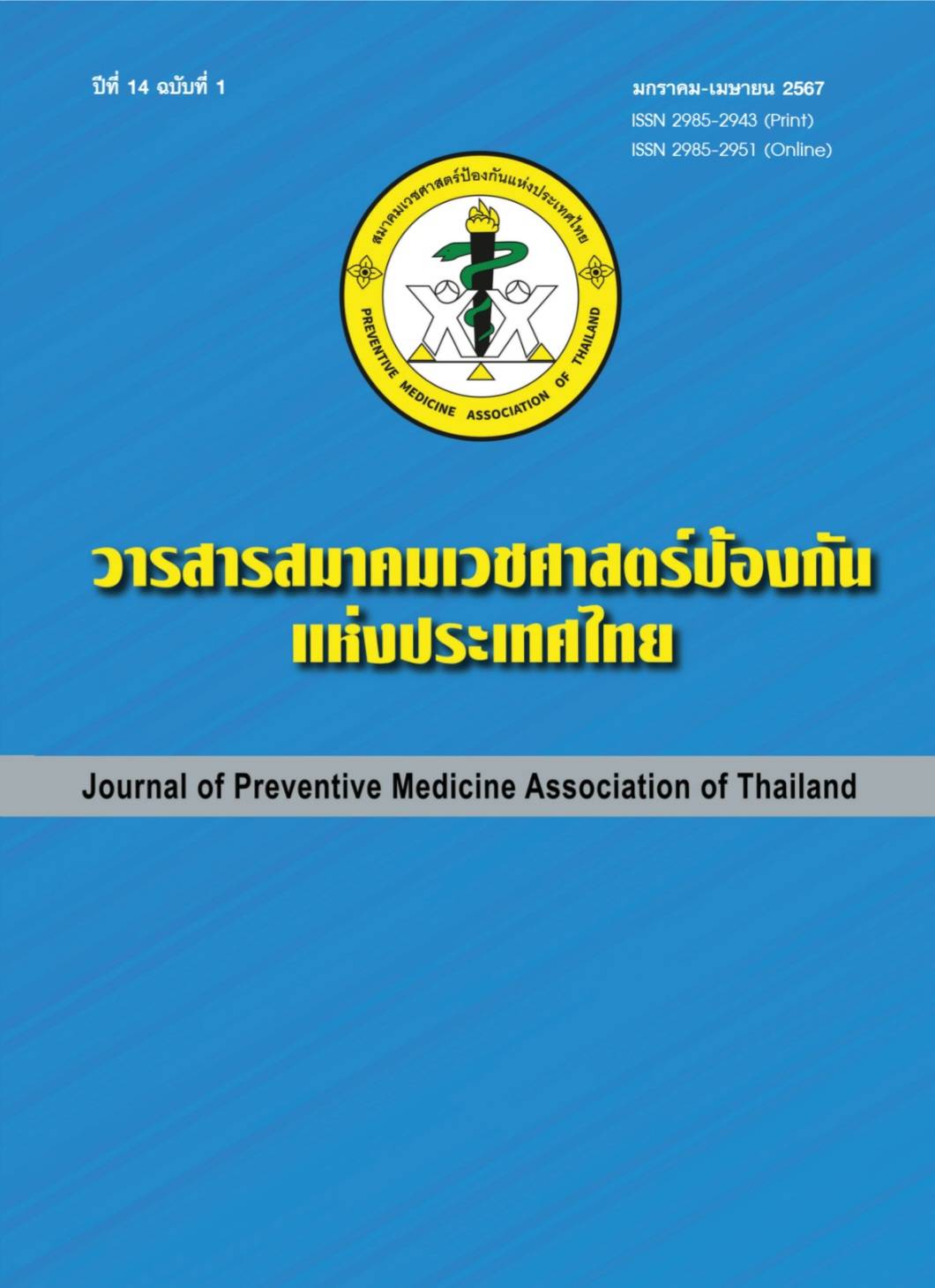Prevalence and Predictive Factors of Postpartum Depression in Chumphae Hospital, Khon Kaen
Keywords:
depression, postpartum depression, postpartum mothersAbstract
Objective: To study the prevalence of postpartum depression, and factors that can predict postpartum depression among postpartum mothers in Chumphae Hospital, Khon Kaen. Methods: This is cross-sectional analytical research. The samples were purposively selected to recruit 306 postpartum mothers within 48-72 hours after giving birth, who gave birth at Chumphae Hospital, Khon Kaen Province, between July and October 2023. The tools used were a general information questionnaire, Stress Test Questionnaire (ST5), and Edinburgh Postnatal Depression Scale (EPDS≥11), which are standard assessments of the Ministry of Public Health, used in maternal and infant health records. The Cronbach's alpha coefficient of ST5 in this study was .81, and EPDS was .75. The data were analyzed using descriptive statistics, and statistical analysis chi-square and binary logistic regression. Results: The prevalence of postpartum depression was found to be 8.5%. Factors that predict postpartum maternal depression, there are mental health problems (ORadj=44.18, p<0.001), had postpartum complications (ORadj=7.34, p=0.014), planned to breastfeed for less than 6 months (ORadj=8.34, p<0.001), and had a birth weight less than 2,500 grams (ORadj=10.08, p<0.001), and explained 33.9% of the variation in postpartum maternal depression (R2=0.339, p<0.001). Conclusions: This study found that the prevalence of depression in the 48-72 hours after birth was quite high. There are the factors of mental health problems, postpartum complications, plan for breastfeeding, and newborn baby weight, which can explain variations in postpartum depression. Therefore, every mother should be assessed for postpartum depression before discharge, to provide mothers with prompt care and assistance, and to prevent, and monitor the occurrence of postpartum depression.
References
Lee MI, Lee JJ, Park S, Kim S, Lee H. Is social support associated with postpartum depression, anxiety, and perceived stress among Korean women within the first year postpartum? J Psychosom Obstet Gynecol 2023;44(1):2231629.
Wang Z, Liu J, Shuai H, Cai Z, Fu X, Lui Y, et al. Mapping global prevalence of depression among postpartum women. Transl Psychiatry 2021;11(1):1-13.
กุสุมล แสนบุญมา, ธัญญมล สุริยานิมิตรสุข, กิตติพร ประชาศรัยสรเดช, นวพร มามาก. ปัจจัยทำนายภาวะซึมเศร้าหลังคลอดในมารดาครรภ์แรก. วารสารพยาบาลกระทรวงสาธารณสุข 2564;31(2):128-39.
วันชัย กิตติโชติวัฒน์. ความชุกและปัจจัยที่เกี่ยวข้องกับภาวะซึมเศร้าหลังคลอดของโรงพยาบาลแก่งคอย จังหวัดสระบุรี. วารสารกรมการแพทย์ 2561;43(5):125-30.
เอกชัย เพ็ชรพรประภาส. ความชุกและปัจจัยที่เกี่ยวข้องกับภาวะซึมเศร้าหลังคลอดในโรงพยาบาลบางพลี จังหวัดสมุทรปราการ. จิตเวชวิทยาสาร 2563;36(2):172-85.
Nurbaeti I, Deoisres W, Hengudomsub P. Postpartum depression in Indonesian mothers: its changes and predicting factors. Pacific Rim Int J Nurs Res 2018;22(2):93-105.
Bina R. Predictors of postpartum depression service use: a theory-informed, integrative systematic review. Women Birth 2020;33(1):24-32.
Tarar AH, Ijaz MM, Tarar MA, Batool M. Postpartum depression: assessment of cultural risk factors. Pak Armed Forces Med J 2021;71(suppl1):s47-51.
Nadzirah R, Salina M, Norley S, Mohamad IS, Omar A. Social support and the associated risk factors for postpartum depression among mothers attending primary care centers in Malaysia. Asian J Psychiatr 2023;23(S):1-12.
Palancı AY O, Aktas S. The effect of maternal functional and postpartum depression status on breastfeeding self-efficacy of the mothers: a cross-sectional study. Health Care Women Int 2024;45(2):236-50.
Tsai JM, Tsay SL, Tsay SL, Chen YH. The prevalence and risk factors of postpartum depression among women during the early postpartum period: a retrospective secondary data analysis. Taiwan J Obstet Gynecol 2023;62(3):406-11.
Smorti M, Ponti L, Pancetti F. A Comprehensive analysis of post-partum depression risk factors: the role of socio-demographic, individual, relational, and delivery characteristics. Front Public Health 2019;7:295.
Elwood J, Murray E, Bell A, Sinclair M, Kernohan WG, Stockdale J. A systematic review investigating if genetic or epigenetic markers are associated with postnatal depression. J Affect Disord 2019;15:253:51-62.
สุพิชญาณีต์ พงษ์พิเดช, ธนพุฒ สุรวัฒนวิเศษภา, กวินนาถ ธนากิจบริสุทธิ์, ภูสิษฎ์ ศีลประชาวงค์, ณหทัย ศรีสุวรรณ, มัชฌิมาพร ชาตกิตติคุณวงศ์, และคณะ. ปัจจัยและประสิทธิภาพของการรักษาภาวะซึมเศร้าหลังคลอดในมารดาวัยผู้ใหญ่ตอนต้น. วชิรเวชสารและวารสารเวชศาสตร์เขตเมือง 2564;65(3):211-20.
กรมอนามัยและสำนักงานหลักประกันสุขภาพแห่งชาติ. สมุดบันทึกสุขภาพแม่และเด็ก (สมุดสีชมพู). นนทบุรี: กระทรวงสาธารณสุข; 2566.
Hsieh FY, Bloch DA, Larsen MD. A simple method of sample size calculation for linear and logistic regression. Statist Med 1998;17(14):1623-34.
ศรุตา ช่อไสว, นงลักษณ์ วรรักษ์ธนานันท์. ความชุกและปัจจัยที่เกี่ยวข้องกับภาวะซึมเศร้าของมารดาหลังคลอดในโรงพยาบาลตาคลี จังหวัดนครสวรรค์. สวรรค์ประชารักษ์เวชสาร 2556;10(30):103-18.
Israel GD. Determining sample size. University of Florida Cooperative Extension Service, Institute of Food and Agriculture Sciences, EDIS: Florida; 1992.
มยุรัตน์ รักเกียรติ์, ประนอม พูลพัฒน์. ความชุกและปัจจัยที่เกี่ยวข้องกับภาวะซึมเศร้าหลังคลอดในมารดาวัยรุ่น โรงพยาบาลนพรัตนราชธานี. วารสารคณะพยาบาลศาสตร์ มหาวิทยาลัยบูรพา 2563;38(1):38-47.
นภัสนันท์ สุขเกษม, รัชนี เรืองพรวิสุทธิ์, พรรณพิไล ศรีอาภรณ์, วีรพันธ์ ศิริฤทธิ์, พรรณา วัชรประภาพงศ์. ปัจจัยทํานายภาวะซึมเศร้าหลังคลอด. วารสารการพยาบาลและการดูแลสุขภาพ 2559;34(1):47-55.
Lowdermilk DL, Perry SE, Cashion K, Alder KR, Olshansky EF. Maternity & women’s health care. 12th ed. St. Loius, USA: Missouri; 2020.
Shorey S, Chee CYI, Ng ED, Chan YH, San Tam WW, Chong YS. Prevalence and incidence of postpartum depression among healthy mothers: a systematic review and meta-analysis. J Psychiatr Res 2018;104:235-48.
Nakano M, Sourander A, Luntamo T, Chudal R, Skokauskas N, Kaneko H. Early risk factors for postpartum depression: a longitudinal Japanese population-based study. J Affect Disord 2020;269:148-53.
Baattaiah BA, Alharbi MD, Babteen NM, Al-Maqbool HM, Babgi FA, Albatati AA. The relationship between fatigue, sleep quality, resilience, and the risk of postpartum depression: an emphasis on maternal mental health. BMC Psychol 2023;11(1):1-17.
Elwood J, Murray E, Bell A, Sinclair M, Kernohan WG, Stockdale J. A systematic review investigating if genetic or epigenetic markers are associated with postnatal depression. J Affect Disord 2019;253:51-62.
สุภัสสรา ภูเมฆ, เอกชัย โควาวิสารัตน์, มาลี เกื้อนพกุล, วรัญญา แสงพิทักษ์. ปัจจัยทำนายภาวะซึมเศร้าของมารดาหลังคลอดที่มารับบริการที่โรงพยาบาลราชวิถี. วารสารวิจัยสุขภาพและการพยาบาล 2562;35(3):158-70.
Tang L, Zhu R, Zhang X. Postpartum depression and social support in China: a cultural perspective. J Health Commu 2016;21990:1055-61.
Downloads
Published
How to Cite
Issue
Section
License
Copyright (c) 2024 สมาคมเวชศาสตร์ป้องกันแห่งประเทศไทย

This work is licensed under a Creative Commons Attribution-NonCommercial-NoDerivatives 4.0 International License.
บทความที่ลงพิมพ์ในวารสารเวชศาสตร์ป้องกันแห่งประเทศไทย ถือเป็นผลงานวิชาการ งานวิจัย วิเคราะห์ วิจารณ์ เป็นความเห็นส่วนตัวของผู้นิพนธ์ กองบรรณาธิการไม่จำเป็นต้องเห็นด้วยเสมอไปและผู้นิพนธ์จะต้องรับผิดชอบต่อบทความของตนเอง






